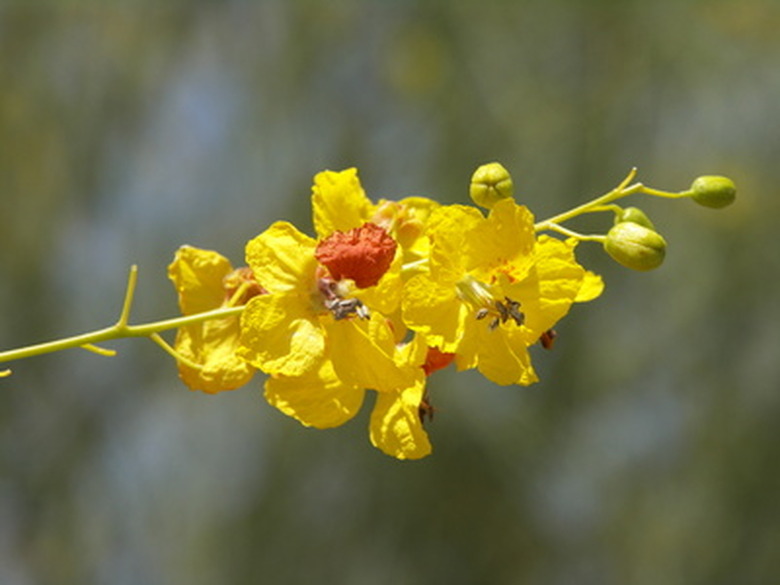How To Plant A Palo Verde Tree
Things Needed
- Garden shovel
- Water source (bucket or hose)
- Measuring tape or stick
Tolerant of intense sunlight, heat and even dry soils, the palo verde tree (Parkinsonia florida) is a good choice for gardens needing shade and pretty springtime flowers. The green young branches gives rise to the common name of palo verde, which translates from Spanish meaning 'green stick.' Make sure this plant receives at least 8 to 10 hours of direct sunshine daily in your garden.
Site Selection
Step 1
Find a spot in your garden that you wish to plant the palo verde tree. Make sure it is in a full sun exposure, receiving at least 8 hours of sun daily.
Step 2
Dig a preliminary hole at the spot you wish to plant the tree. Make the hole 12 to 18 inches deep, and no more than 8 to 12 inches wide.
- Tolerant of intense sunlight, heat and even dry soils, the palo verde tree (Parkinsonia florida) is a good choice for gardens needing shade and pretty springtime flowers.
- Dig a preliminary hole at the spot you wish to plant the tree.
Step 3
Fill the preliminary hole completely with water. Take note every hour thereafter, seeing how long it takes for the water in the hole to soak away. If the hole takes longer than 8 hours to completely drain, abandon this location as a place for the palo verde tree.
Step 4
Repeat steps 1 through 3 until you find a location in the garden that has proper drainage.
Tree Planting
Step 1
Measure the width and height of the root ball of the palo verde tree in the container it grows. The height of the root ball must be measured from the bottom of the container only to the top of the soil, not the rim of the container.
Step 2
Enlarge the hole made in section 1, where you will plant your tree, with a garden shovel to a size that is 3 to 5 times as wide as the root ball. Make the depth of the hole the same depth as the root ball. For example, if your root ball measurements are 12 inches tall by 12 inches wide, make the planting hole 3 to 6 feet wide, but only 12 inches deep.
- Fill the preliminary hole completely with water.
- Enlarge the hole made in section 1, where you will plant your tree, with a garden shovel to a size that is 3 to 5 times as wide as the root ball.
Step 3
Remove the tree from its nursery container, taking care not to crush, break or loosen the root ball once pulled out.
Step 4
Gently position the tree in the center of the planting hole so that it rests perfectly upright. Turn the tree in the hole to situate any branches or "face" of the plant to your liking.
Step 5
Replace the soil back into the hole–first placing soil around the base of the tree's root ball to help stabilize the plant. Do not add any amendments to the back-fill soil, as this may encourage the tree to grow roots in a smaller area rather than reaching its roots out into the far reaches of the native soil.
Step 6
Lightly tamp the soil in the hole as it is filled. Make sure the top of the tree's root ball is neither covered with soil nor rests below the average soil level after planting.
- Remove the tree from its nursery container, taking care not to crush, break or loosen the root ball once pulled out.
- Turn the tree in the hole to situate any branches or "face" of the plant to your liking.
Step 7
Make a low berm around the base of the tree to create a catch-basin for irrigation water. The berm needs only be 3 to 5 inches tall, and with a diameter of 2 to 4 feet.
Step 8
Add water to the catch-basin at the base of the tree until it is full. Allow the water to soak into the soil and repeat again two or three more times to ensure the soil is moistened thoroughly and deeply.
Step 9
Add more soil to the planting hole if the watering causes the soil to compact and drop below the height of the tree's root ball.
Tip
If you plant your tree in a windy location, or at the start of the rainy season, consider staking the tree to prevent it tipping or leaning while it establishes its roots for the first year.
Warning
Do not plant trees too deeply. Although the results are not immediately seen, tree trunk flares that are covered in soil will slowly rot and suffocate the roots, eventually killing the tree in two to ten years.
